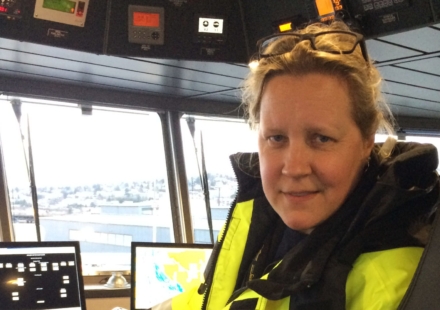Shannon Ford Ward
Captain, f/v Paul Revere

I am so thankful to have been born into something that's become extremely rare on earth; a harvestable species that still thrives at historical levels.
When did you first step on to a commercial fishing boat? (is it a family business, do you have some heritage connection, or are you newer to the industry?)
I was a small child! My family has been commercial fishing in Alaska for 5 generations now, starting in 1933; that makes this year our 90th anniversary. They were fishermen in coastal Washington state prior to moving to Alaska during the Gold Rush and Great Depression. Our family Fish Camp has been in existence since the 1950’s. When I was 9, I was sent to Fish Camp to work for my grandmother. I’d been there before, but this was the first year on the payroll. It’s a family tradition that I’m so pleased to share now with my own daughter. She’s 6 years old now, and her first season was as a 6 month old baby.
Are people within Alaska surprised by your career path?
No, not at all. It’s a statewide point of pride, I think, to continue harvesting and sharing our resources. Alaska has more coastline than the other 49 states combined (including Hawaii!), so fishing and water-based industries are a main focus.
What do you love about your job?
So many things! I love being at our family camp with my cousins, and now my husband and daughter. It’s a lifetime of memories plus the connections back to previous generations. We have the privilege of being so close to wildlife on a daily basis: bears, eagles, beluga whales, foxes, ravens, migratory shorebirds, and more. Being so close to weather and nature’s patterns is a mental re-set, too, from the rest of the year where I live with modern conveniences and the more frantic pace of normal life. At camp, we have no electricity or running water. We spend leisure time picking berries, walking on the beach, having community bonfires, sharing meals, reading, playing games, and lots and lots of visiting. The excitement of seeing a net fill with perfect shining salmon is something that never, ever gets old! We always eat a fresh fish from the first tide of the season. I’m obsessed with this food myself, so catching it to feed the world is the ultimate fulfilling career. I know with absolute certainty that I’m part of an industry that provides the planet’s most perfect protein! And as we enjoy record massive runs of salmon returning each year, it’s a totally sustainable resource that should continue for generations to come. I am so thankful to have been born into something that’s become extremely rare on earth; a harvestable species that still thrives at historical levels. Biologists have done core samples, and our salmon are returning in the same average numbers as they have as far back as the record may be traced.
In a few sentences, how would you describe the culture of Alaska seafood and fishing to people?
Alaska’s seafood and fishing culture is as much a part of the yearly cycle as Christmas or the start of school. We structure our lives around our fishing seasons. Even when it’s not that time of year, we are talking to each other about it, making plans, buying equipment, and obsessively checking predictions and reports! Besides the commercial aspect, subsistence and personal home use is as normal as going to the grocery store might be somewhere else. Families will return to their home villages to put up fish for the winter, often sending a supply to members who might live elsewhere. Providing for the elders is a common practice. It’s an activity that brings whole communities together. We all look forward to seeing each other again every summer! Our families have been friends for generations, and though we may live elsewhere in the winter, we all come back to the same place each spring – just like the salmon.


What are some of the ways your boat(s) work(s) ‘with’ the ecosystem to ensure sustainability?
As are all of Alaska’s fisheries, we are regulated to protect future production and returns. Based on the biologist’s research, the Alaska Department of Fish and Game establishes escapement goals for the season – that is, how many salmon they want to get up the rivers to spawn and produce for coming years. During the fishing time, they count how many fish get there and open / close our fishing periods to make sure the goal is reached. This system was established with statehood. Alaska has been a sustainable ecosystem for its natural resources since the beginning – a unique and wonderful thing. We also use biodegradable soaps for cleaning the boat, gear, ourselves, and our clothes. We take good care of our camp and the area of tundra that’s our seasonal home. And we take our rubbish to an approved station, including anything that might wash up on the beach from other boats.
What would you like to see for the next generation of Alaska’s fishing communities?
I would love to see more families able to make enough of a living to include upcoming generations in the commercial fisheries. This includes infrastructure, education, and work opportunities. Part of that picture would also feature preserving and passing on the traditions of heritage foods. These waters have sustained humans for thousands of years. Continuing to appreciate and benefit from the seafood is both a right and a privilege. I love seeing the elders teach what they have done their entire lives. The way I make caviar (salmon roe) is a direct result of learning from one of our village elders when I was interested in making my own. Now my daughter sits beside me and helps, so she also will know how to make it.



